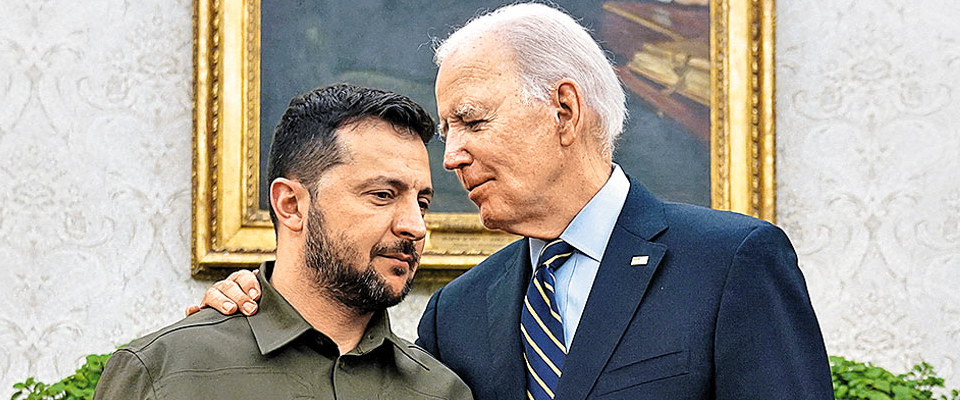The Russia-Ukraine war is the "Best Textbook."

“What can a major country’s military learn from the Russia-Ukraine conflict?” asked a sharp military expert. With a touch of humor, he added, “Keep in mind that there are Americans present.”
On March 27th, during the 6th International Forum on Strategy and Security at the Center for International Security and Strategy (CISS) of Tsinghua University, a discussion on the Russia-Ukraine conflict took place. The researcher from the center, Zhou Bo, posed a question to another military expert, Li Li. As the conflict between Russia and Ukraine enters its third year with no clear resolution, the situation remains deadlocked.
Li Li, an experienced military researcher, didn’t appear to be taken aback by the somewhat unexpected question. She quickly provided her perspective, stating, “In fact, I believe that any military, whether it’s the Chinese, Indian, Korean, or even the U.S. military, can learn a lot from the Russia-Ukraine conflict.”
Li Li emphasized the need to adapt tactics, theories, and equipment systems to the latest changes in modern warfare. She noted that in the first year of the conflict, Russia was relatively passive and unprepared for the situation, despite receiving assistance from dozens of countries supporting Ukraine. Additionally, Russia lacked experience in dealing with new forces like unmanned aerial vehicles (UAVs) and the flexible offensives carried out by the Ukrainian military in a large-scale maneuver mode using the “Starlink” system.
At the beginning of the Russia-Ukraine conflict in February 2022, SpaceX donated approximately 20,000 “Starlink” terminals, which played a crucial role in communication on the Ukrainian battlefield. The “Starlink” system utilizes a large number of low-earth orbit satellites to provide high-speed communication services, making it a portable internet solution that doesn’t rely on traditional ground infrastructure. It quickly became a core equipment for Ukraine’s external communication and military command.
“Any military needs to make adjustments after experiencing losses, and the first step is to decentralize command, combat authority, and decision-making power to the frontline. Only through dynamic responses to dynamic situations can victory be achieved,” Li Li continued. She further mentioned that in the second year of the conflict, Russia made significant changes and produced a large number of ZALA Lancet, which are inexpensive, plentiful, and effective.
According to previous reports by “Reference News,” this UAV was developed by the Zala Aero Group, a subsidiary of the Kalashnikov Group. The Russian military currently uses two versions of the ZALA Lancet. The smaller variant can carry a 1-kilogram payload and fly for 30 minutes, while the larger version can carry 3 kilograms of explosives and fly for 40 minutes.
Li Li’s analysis points out, “When both sides of the Russia-Ukraine conflict reach a certain equilibrium in terms of combat and confrontation, there will be changes on the front line.” As a follow-up, Ukraine also needs to defend against Russia’s UAVs, and both sides need to deploy fishing nets. This may seem rudimentary and unimaginable to us, but now both sides are using these measures.
In addition to adjusting combat strategies based on the latest changes on the battlefield and from the adversary, Li Li believes that we need to fully recognize the arrival of the information age in our concept of warfare. “Today’s warfare is fundamentally different from what it was five or ten years ago because there have been significant changes in the underlying new technologies in society. For example, the current application of AI technology in warfare.”
A recent cover story in Time magazine referred to the protracted Russia-Ukraine conflict as “the first AI war.” The report mentioned that shortly after the outbreak of the conflict, the CEO of Palantir Technologies, an American company, visited Kyiv and met with Ukrainian President Zelensky. Subsequently, cooperation between the two sides progressed rapidly. It is reported that on the Russia-Ukraine battlefield, Palantir’s software uses AI to analyze satellite images, open-source data, footage from UAVs, and ground reports to provide military decision-making advice to Ukrainian commanders. AI models can suggest the most effective options for targeting enemy positions.
Regarding the use of the latest technology on the battlefield, Li Li reminds us that if we fail to see the changes, it will be difficult to adapt to them.
“Therefore, we must learn from warfare, and the ongoing war is our best teaching material.”





